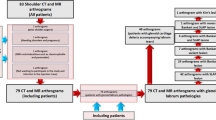Abstract
Purpose
Among late signs like sclerosis, cysts and osteophytes, alteration of cartilage is a common problem in osteoarthritis. To detect abnormal states in the glenohumeral joint, the physiologic distribution of the cartilage thickness must be known, which will allow physicians to better advise patients. High-resolution computed tomography (CT) data in soft tissue kernel provide highly accurate quantitative results and are a useful method to determine the geometrical situation of the glenohumeral joint. The objective of this study was to characterize the distribution of the thickness of the glenohumeral joint cartilage using CT.
Methods
To investigate the distribution of thickness of the joint cartilage, CT images in soft tissue kernel of nine specimens were analyzed using image visualization software. Statistical analysis of the obtained data was performed using the ANOVA test.
Results
Results showed different patterns in the glenoid cavity than in humeral head. Cartilage thickness in all glenoids showed maxima in the inferior and anterior portion, whereas central areas are covered with the thinnest cartilage layer. Maximum cartilage thickness in the humeral head was found in the central and superior parts.
Conclusion
We could show that the distribution of cartilage thickness in the glenohumeral joint is not homogenous and that there exist several reproducible patterns. Evaluation of cartilage thickness in the glenohumeral joint is of high interest in basic and clinical research.



Similar content being viewed by others
References
Adam C, Eckstein F, Milz S, Putz R (1998) The distribution of cartilage thickness within the joints of the lower limb of elderly individuals. J Anat 193(Pt 2):203–214
Ateshian GA, Soslowsky LJ, Mow VC (1991) Quantitation of articular surface topography and cartilage thickness in knee joints using stereophotogrammetry. J Biomech 24(8):761–776
Billuart F, Devun L, Gagey O, Skalli W, Mitton D (2007) 3D kinematics of the glenohumeral joint during abduction motion: an ex vivo study. Surg Radiol Anat 29(4):291–295. doi:10.1007/s00276-007-0208-2
De Wilde L, Defoort S, Verstraeten TR, Speeckaert W, Debeer P (2012) A 3D-CT scan study of the humeral and glenoid planes in 150 normal shoulders. Surg Radiol Anat 34(8):743–750. doi:10.1007/s00276-011-0836-4
Eckstein F, Hudelmaier M, Putz R (2006) The effects of exercise on human articular cartilage. J Anat 208(4):491–512. doi:10.1111/j.1469-7580.2006.00546.x
Graichen H, Jakob J, von Eisenhart-Rothe R, Englmeier KH, Reiser M, Eckstein F (2003) Validation of cartilage volume and thickness measurements in the human shoulder with quantitative magnetic resonance imaging. Osteoarthr Cartil 11(7):475–482
Hodler J, Loredo RA, Longo C, Trudell D, Yu JS, Resnick D (1995) Assessment of articular cartilage thickness of the humeral head: MR-anatomic correlation in cadavers. AJR Am J Roentgenol 165(3):615–620. doi:10.2214/ajr.165.3.7645480
Kraljevic M, Zumstein V, Hugli R, Muller-Gerbl M (2012) A comparison of subchondral bone mineralization between the glenoid cavity and the humeral head on 57 cadaverous shoulder joints. Surg Radiol Anat. doi:10.1007/s00276-012-1034-8
Mann RW (2001) Comment on ‘ultrasonic measurement of the thickness of human articular cartilage in situ’ by Yao and Seedhom. Rheumatology (Oxford) 40(7):829–831
Merrill A, Guzman K, Miller SL (2009) Gender differences in glenoid anatomy: an anatomic study. Surg Radiol Anat 31(3):183–189. doi:10.1007/s00276-008-0425-3
Modest VE, Murphy MC, Mann RW (1989) Optical verification of a technique for in situ ultrasonic measurement of articular cartilage thickness. J Biomech 22(2):171–176
Muller-Gerbl M, Putz R, Hodapp N, Schulte E, Wimmer B (1989) Computed tomography–osteoabsorptiometry for assessing the density distribution of subchondral bone as a measure of long-term mechanical adaptation in individual joints. Skeletal Radiol 18(7):507–512. doi:10.1007/BF00351749
Nowakowski AM, Muller-Gerbl M, Valderrabano V (2012) Assessment of knee implant alignment using coordinate measurement on three-dimensional computed tomography reconstructions. Surg Innov 19(4):375–384. doi:10.1177/1553350611429689
Pollard TC, Gwilym SE, Carr AJ (2008) The assessment of early osteoarthritis. J Bone Joint Surg Br 90(4):411–421. doi:10.1302/0301-620X.90B4.20284
Reuther KE, Sarver JJ, Schultz SM, Lee CS, Sehgal CM, Glaser DL, Soslowsky LJ (2012) Glenoid cartilage mechanical properties decrease after rotator cuff tears in a rat model. J Orthop Res 30(9):1435–1439. doi:10.1002/jor.22100
Ruckstuhl H, Krzycki J, Petrou N, Vanwanseele B, Stussi E (2008) A quantitative study of humeral cartilage in individuals with spinal cord injury. Spinal Cord 46(2):129–134. doi:10.1038/sj.sc.3102084
Rushfeldt PD, Mann RW, Harris WH (1981) Improved techniques for measuring in vitro the geometry and pressure distribution in the human acetabulum—I. Ultrasonic measurement of acetabular surfaces, sphericity and cartilage thickness. J Biomech 14(4):253–260
Soslowsky LJ, Flatow EL, Bigliani LU, Mow VC (1992) Articular geometry of the glenohumeral joint. Clin Orthop Relat Res 285:181–190
Sun HB (2010) Mechanical loading, cartilage degradation, and arthritis. Ann NY Acad Sci 1211:37–50. doi:10.1111/j.1749-6632.2010.05808.x
Zumstein V, Kraljevic M, Huegli R, Muller-Gerbl M (2011) Mineralisation patterns in the subchondral bone plate of the humeral head. Surg Radiol Anat 33(9):775–779. doi:10.1007/s00276-011-0819-5
Conflict of interest
The authors declare that they have no financial and personal relationships with other people or organizations that could inappropriately influence their work.
Author information
Authors and Affiliations
Corresponding author
Additional information
V. Zumstein and M. Kraljević contributed equally to this work.
Rights and permissions
About this article
Cite this article
Zumstein, V., Kraljević, M., Conzen, A. et al. Thickness distribution of the glenohumeral joint cartilage: a quantitative study using computed tomography. Surg Radiol Anat 36, 327–331 (2014). https://doi.org/10.1007/s00276-013-1221-2
Received:
Accepted:
Published:
Issue Date:
DOI: https://doi.org/10.1007/s00276-013-1221-2




